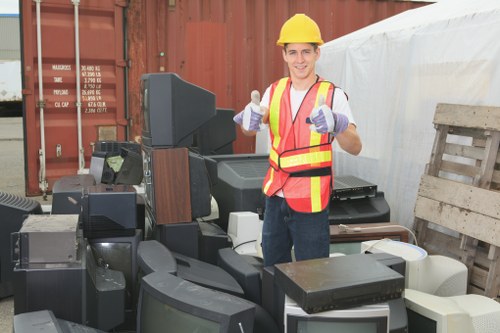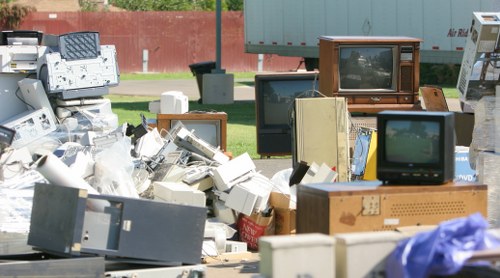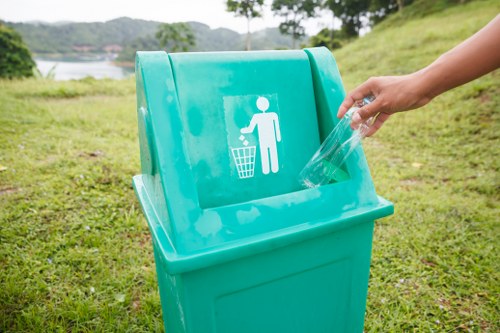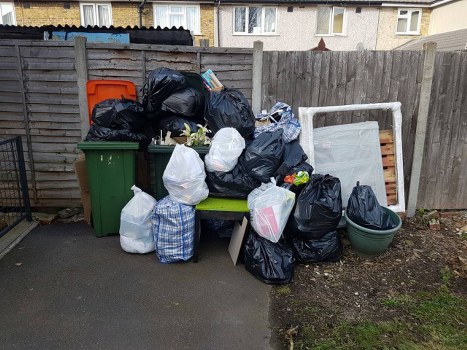Flat Clearance in Commercial Waste Disposal
Understanding Flat Clearance

Flat clearance is a critical service in the realm of commercial waste disposal. It involves the systematic removal of unwanted items from commercial properties, ensuring that spaces remain clean, safe, and compliant with regulations. Whether you're renovating an office, relocating, or simply decluttering, flat clearance plays a vital role in maintaining a productive business environment.
Effective flat clearance not only helps in managing waste efficiently but also contributes to sustainability efforts by promoting recycling and responsible disposal practices. Businesses can significantly reduce their environmental footprint by partnering with professional waste disposal services that prioritize eco-friendly methods.
Moreover, proper flat clearance can enhance the aesthetic appeal of commercial spaces, making them more inviting for clients and employees alike. A clutter-free environment fosters better concentration, reduces stress, and can even boost overall productivity.
The Importance of Commercial Waste Disposal

In the commercial sector, waste disposal is more than just removing trash; it's about managing resources responsibly. Businesses generate a significant amount of waste daily, ranging from office supplies to large-scale industrial byproducts. Without an effective waste disposal strategy, this waste can accumulate, leading to operational inefficiencies and potential health hazards.
Implementing a robust waste disposal system helps businesses comply with local and federal regulations, avoiding hefty fines and legal issues. It also demonstrates a company's commitment to environmental stewardship, which can enhance its reputation and appeal to eco-conscious consumers and partners.
Furthermore, commercial waste disposal services often provide specialized solutions tailored to different industries. Whether it's confidential document shredding for corporate offices or hazardous waste handling for manufacturing plants, professional disposal services ensure that all waste is managed safely and appropriately.
Key Components of Flat Clearance

Flat clearance typically involves several key components to ensure a comprehensive service. These include:
- Assessment: Evaluating the amount and type of waste to determine the best disposal methods.
- Sorting: Separating recyclable materials from non-recyclable ones to promote sustainability.
- Transportation: Safely moving waste from the property to designated disposal or recycling facilities.
- Disposal: Ensuring that all waste is disposed of in compliance with environmental regulations.
Each step is meticulously planned and executed to minimize disruption to business operations while maximizing efficiency and environmental responsibility.
Benefits of Professional Flat Clearance

Engaging a professional flat clearance service offers numerous benefits for businesses:
- Time-Saving: Professionals handle all aspects of waste removal, allowing businesses to focus on their core operations.
- Expertise: Trained personnel ensure that waste is handled safely and disposed of correctly.
- Cost-Effective: Outsourcing waste disposal can be more economical than managing it in-house, especially when considering the costs of equipment and labor.
- Environmental Compliance: Professionals stay updated on the latest regulations, ensuring that businesses remain compliant.
These benefits collectively contribute to a smoother, more efficient waste management process, enhancing overall business performance.
Implementing an Effective Flat Clearance Strategy

To implement an effective flat clearance strategy, businesses should consider the following steps:
- Conducting Regular Audits: Assessing waste generation patterns to identify areas for improvement.
- Setting Clear Objectives: Defining goals for waste reduction, recycling, and responsible disposal.
- Training Staff: Educating employees on proper waste segregation and disposal practices.
- Partnering with Reliable Services: Choosing a waste disposal partner that aligns with the company's sustainability goals.
- Monitoring and Reviewing: Continuously evaluating the effectiveness of the waste disposal strategy and making necessary adjustments.
By following these steps, businesses can establish a robust flat clearance system that not only manages waste efficiently but also supports overall sustainability initiatives.
Challenges in Commercial Waste Disposal
Despite its importance, commercial waste disposal comes with its set of challenges:
One of the primary challenges is the complexity of waste types and the need for specialized handling. For instance, electronic waste, medical waste, and hazardous materials all require specific disposal methods to prevent environmental contamination and ensure safety.
Another challenge is the rising cost of waste disposal services. As regulations become more stringent and the push for sustainability increases, disposal costs can escalate, particularly for businesses generating large volumes of specialized waste.
Regulatory Compliance

Staying compliant with ever-changing waste disposal regulations is a significant hurdle. Non-compliance can result in legal penalties, fines, and damage to a company's reputation. Therefore, businesses must stay informed about local, state, and federal regulations and work with disposal services that prioritize compliance.
Innovations in Waste Disposal
Advancements in technology are revolutionizing the waste disposal industry. Innovations such as waste-to-energy systems, which convert waste into usable energy, and enhanced recycling techniques are making waste management more sustainable and efficient.
Additionally, digital tools and software are improving the tracking and management of waste, allowing businesses to monitor their waste streams in real-time and make data-driven decisions to reduce waste generation.
These innovations not only enhance the effectiveness of waste disposal but also contribute to broader environmental goals by reducing landfill use and promoting the circular economy.
Choosing the Right Waste Disposal Partner
Selecting the appropriate waste disposal partner is crucial for successful flat clearance. Businesses should consider factors such as the provider's experience, range of services, commitment to sustainability, and compliance track record.
It's also important to assess the provider's customer service and responsiveness. A reliable partner will offer flexible scheduling, transparent pricing, and tailored solutions to meet the specific needs of the business.
By carefully evaluating potential partners, businesses can ensure that their waste disposal needs are met efficiently and responsibly.
Cost Considerations
Understanding the cost structure of flat clearance services is essential for budgeting and financial planning. Costs can vary based on factors such as the volume of waste, type of materials, frequency of pickups, and specific disposal requirements.
Businesses should request detailed quotes and compare offerings from multiple providers to ensure they are receiving competitive pricing without compromising on service quality.
Additionally, investing in efficient waste management practices can lead to long-term savings by reducing waste generation and minimizing disposal fees.
Sustainability and Flat Clearance
Sustainability is a key consideration in modern waste disposal. Businesses are increasingly seeking flat clearance solutions that align with their environmental values and contribute to their sustainability goals.
Implementing sustainable practices such as recycling, composting, and minimizing single-use materials can significantly reduce a company's environmental impact.
Partnering with waste disposal services that prioritize sustainable methods ensures that flat clearance efforts support broader environmental initiatives and promote corporate responsibility.
Regulatory Framework
Understanding the regulatory framework surrounding commercial waste disposal is essential for compliance and effective waste management.
- Local Regulations: Municipalities often have specific rules regarding waste collection, recycling, and disposal.
- State Laws: State-level regulations may dictate how certain types of waste must be handled and disposed of.
- Federal Guidelines: Federal agencies set overarching policies to ensure national standards for waste management.
Staying informed about these regulations helps businesses avoid legal pitfalls and adopt best practices in waste disposal.
Technology in Waste Management
Technology is playing an increasingly important role in waste management, enhancing the efficiency and effectiveness of flat clearance services.
Innovations such as RFID tagging, GPS tracking, and automated sorting systems are streamlining waste collection and processing. These technologies enable real-time monitoring, accurate data collection, and improved operational logistics.
Moreover, data analytics provide valuable insights into waste generation patterns, helping businesses identify areas for waste reduction and implement targeted strategies for improvement.
Employee Training and Awareness
Employee involvement is crucial in the success of flat clearance and waste management strategies. Training programs that educate staff on proper waste segregation, recycling practices, and disposal procedures can significantly enhance the effectiveness of waste management efforts.
Awareness campaigns that highlight the importance of sustainability and responsible waste disposal foster a culture of environmental responsibility within the organization.
Engaged and informed employees are more likely to adopt and maintain waste reduction practices, contributing to the overall success of the company's sustainability initiatives.
Future Trends in Commercial Waste Disposal
The commercial waste disposal landscape is continually evolving, with several emerging trends shaping its future:
- Increased Automation: Automation is set to revolutionize waste sorting and processing, making operations more efficient and reducing the need for manual labor.
- Circular Economy Models: Businesses are adopting circular economy principles, focusing on reducing waste generation and promoting the reuse and recycling of materials.
- Green Certifications: Certifications and standards for sustainable waste management are becoming more prevalent, encouraging businesses to adopt eco-friendly practices.
- Advanced Recycling Technologies: Innovations in recycling technologies are enabling the processing of a wider range of materials, enhancing recycling rates.
Staying abreast of these trends allows businesses to adapt their waste management strategies, ensuring long-term sustainability and compliance.
Conclusion
Flat clearance is an essential component of commercial waste disposal, playing a pivotal role in maintaining clean, safe, and sustainable business environments. By understanding its importance, implementing effective strategies, and partnering with reliable waste disposal services, businesses can manage their waste efficiently while minimizing their environmental impact.
Embracing sustainable practices, leveraging technological advancements, and fostering employee engagement further enhance the effectiveness of flat clearance efforts, contributing to overall operational excellence and corporate responsibility.
For businesses looking to streamline their waste management processes and uphold their commitment to sustainability, professional flat clearance services offer a comprehensive and reliable solution. Contact us today to book your service and take the first step towards a cleaner, greener business environment.